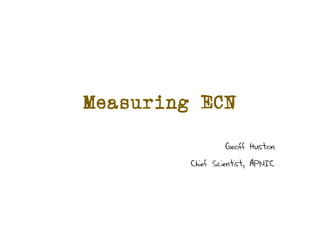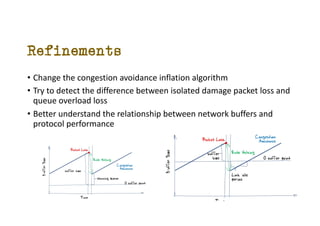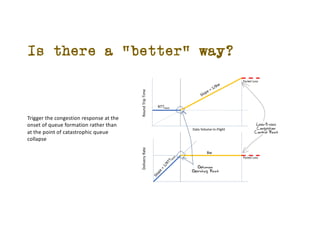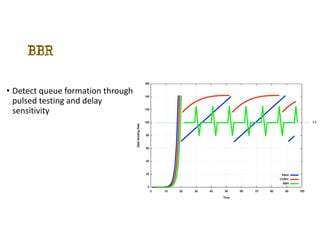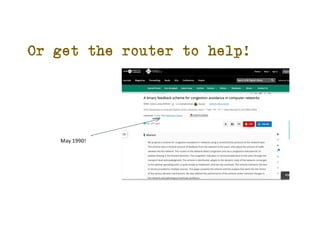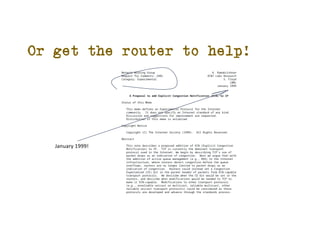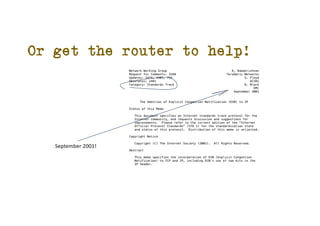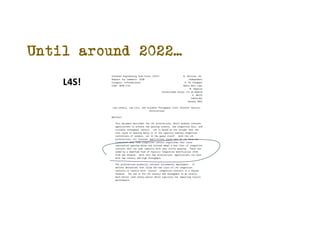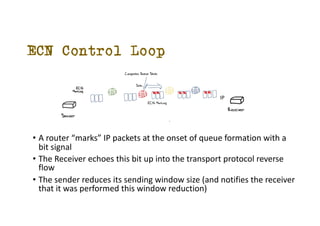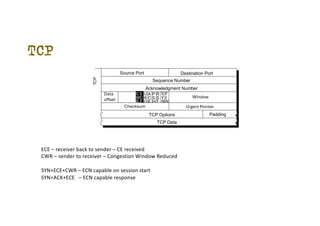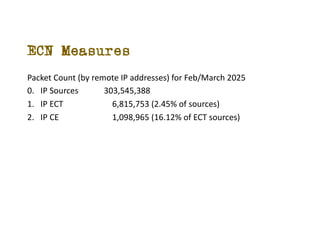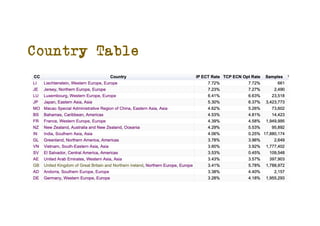Measuring ECN, presented by Geoff Huston at IETF 122
- 1. Measuring ECN Geoff Huston Chief Scientist, APNIC
- 2. Loss-Based Congestion Control ? Most of today¡¯s network traffic uses an extremely simple algorithm that avoids networks collapsing under extreme overload: ? Continually increase the amount of data being pushed into the network ? Until a network queue overloads and the sender detects the consequent packet loss ? Halve the sending rate and do it again!
- 3. Refinements ? Change the congestion avoidance inflation algorithm ? Try to detect the difference between isolated damage packet loss and queue overload loss ? Better understand the relationship between network buffers and protocol performance
- 4. Is there a ¡°better¡± way? Trigger the congestion response at the onset of queue formation rather than at the point of catastrophic queue collapse
- 5. BBR ? Detect queue formation through pulsed testing and delay sensitivity
- 6. Or get the router to help! May 1990!
- 7. Or get the router to help! January 1999!
- 8. Or get the router to help! January 1999!
- 9. Or get the router to help! September 2001!
- 12. ECN Control Loop ? A router ¡°marks¡± IP packets at the onset of queue formation with a bit signal ? The Receiver echoes this bit up into the transport protocol reverse flow ? The sender reduces its sending window size (and notifies the receiver that it was performed this window reduction) IP TCP
- 13. ECN Control Loop ? A router ¡°marks¡± IP packets at the onset of queue formation with a bit signal ? The Receiver echoes this bit up into the transport protocol reverse flow ? The sender reduces its sending window size (and notifies the receiver that it was performed this window reduction) IP TCP
- 14. IP Header Version IHL Total Length Flags Identification Fragment Offset Time To Live Source Address Destination Address Options Padding Protocol Header Checksum Type of Service Precedence 0 1 2 3 4 5 6 7 D T R 0 0 Version Traffic Class Flow Label Payload Length Next Header Hop Limit Source Address Destination Address ECN Bits 0 0 ¨C Non-ECN Capable Transport 0 1 ¨C ECN Capable TransporT 1 0 - ECN Capable Transport 1 1 ¨C Congestion Experienced
- 15. TCP TCP Destination Port Source Port Sequence Number Acknowledgment Number Data offset F I N S Y N U R G A C K P S H R S T Window Checksum Urgent Pointer Padding TCP Options TCP Data E C E C W R ECE ¨C receiver back to sender ¨C CE received CWR ¨C sender to receiver ¨C Congestion Window Reduced SYN+ECE+CWR ¨C ECN capable on session start SYN+ACK+ECE ¨C ECN capable response
- 16. ECN Measures Packet Count (by remote IP addresses) for Feb/March 2025 0. IP Sources 303,545,388 1. IP ECT 6,815,753 (2.45% of sources) 2. IP CE 1,098,965 (16.12% of ECT sources)
- 17. ECN Measures Packet Count (by remote IP addresses) 0. IP Sources 303,545,388 1. IP ECT 6,815,753 (2.45% of sources) 2. IP CE 1,098,965 (16.12% of ECT sources) 3. TCP ECN Opt 7,478,207 (2.46% of sources) 4. TCP ECE (Rec¡¯d) 20,862 (0.27% of TCP sources) 5. TCP CWR (Rec¡¯d) 335,209 (4.48% of TCP sources)
- 18. IP ECT by Country
- 19. TCP ECN Option by Country
- 20. Country Table
- 21. Thanks!

